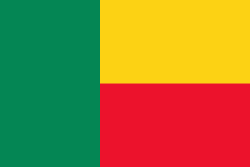Atlantique Department (Atlantique Department)
Atlantique is one of the twelve departments in Benin. The department is located in south-central Benin along the Atlantic coast, between Mono and Kouffo Department in the west, Zou in the north, and Ouémé in the east. The department of Atlantique was bifurcated in 1999 when some of its territories was transferred to the newly formed Littoral Department.
, the total population of the department was 1,398,229, with 686,747 males and 711,482 females. The proportion of women was 50.90%. The total rural population was 55.50%, while the urban population was 44.50%. The total labour force in the department was 433,515, of which 43.40% were women. The proportion of households with no level of education was 39.20% and the proportion of households with children attending school was 77.30%.
Atlantique Department border Zou Department to the north, Ouémé Department to the east, Littoral Department to the south-east, the Atlantic Ocean to the south, and Kouffo Department and Mono Department to the west. The coastal areas have interconnected lakes and lagoons and elongated coastlines with wide marshes; part of Lake Nokoué lies within the department. The southern regions of Benin receive two seasons of rainfall from March to July and September to November, while the northern regions of the country receive one season of rainfall from May to September. The country receives an average annual rainfall of around 1200 mm, but Atlantique Department receives less rainfall. The department has mostly low-lying sandy coastal plains towards the Atlantic Ocean, marshes, lagoons and lakes. The highest elevation in the department around the coastal plains is 20 m, compared to the country's average of 200 m above mean sea level.
, the total population of the department was 1,398,229, with 686,747 males and 711,482 females. The proportion of women was 50.90%. The total rural population was 55.50%, while the urban population was 44.50%. The total labour force in the department was 433,515, of which 43.40% were women. The proportion of households with no level of education was 39.20% and the proportion of households with children attending school was 77.30%.
Atlantique Department border Zou Department to the north, Ouémé Department to the east, Littoral Department to the south-east, the Atlantic Ocean to the south, and Kouffo Department and Mono Department to the west. The coastal areas have interconnected lakes and lagoons and elongated coastlines with wide marshes; part of Lake Nokoué lies within the department. The southern regions of Benin receive two seasons of rainfall from March to July and September to November, while the northern regions of the country receive one season of rainfall from May to September. The country receives an average annual rainfall of around 1200 mm, but Atlantique Department receives less rainfall. The department has mostly low-lying sandy coastal plains towards the Atlantic Ocean, marshes, lagoons and lakes. The highest elevation in the department around the coastal plains is 20 m, compared to the country's average of 200 m above mean sea level.
Map - Atlantique Department (Atlantique Department)
Map
Country - Benin
 |
 |
| Flag of Benin | |
From the 17th to the 19th century, political entities in the area included the Kingdom of Dahomey, the city-state of Porto-Novo, and other states to the north. This region was referred to as the Slave Coast from the early 17th century due to the high number of people who were sold and trafficked during the Atlantic slave trade to the New World. France took over the territory in 1894, incorporating it into French West Africa as French Dahomey. In 1960, Dahomey gained full independence from France. As a sovereign state, Benin has had democratic governments, military coups, and military governments. A self-described Marxist–Leninist state called the People's Republic of Benin existed between 1975 and 1990. In 1991, it was replaced by the multi-party Republic of Benin.
Currency / Language
| ISO | Currency | Symbol | Significant figures |
|---|---|---|---|
| XOF | West African CFA franc | Fr | 0 |
| ISO | Language |
|---|---|
| FR | French language |















